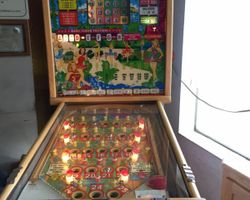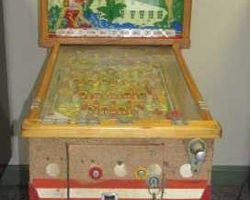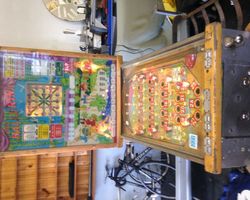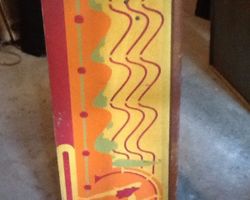Ballerina

Average Prices: USD $100 to $600
Produced: 0
Production Run: 750 units
Machine Type: Electro-mechanical
Players: 1
Design by: Don Hooker
"Ballerina," released in April 1959 by Bally Manufacturing Corporation, represents a unique chapter in the history of electro-mechanical amusement devices. While often categorized under the broader umbrella of pinball, "Ballerina" is distinctively a bingo machine, a specialized genre where players aim to complete numbered patterns on a backglass display rather than achieve high scores through flipper skill alone. Bally, a dominant force in the arcade and amusement industry, had a prolific output of bingo machines during this era, and "Ballerina" emerged as a notable example, distinguished by its innovative features and elegant presentation.
The creation of "Ballerina" was overseen by designer Don Hooker, a significant contributor to Bally’s extensive catalog of EM machines. His design philosophy for "Ballerina" focused on enhancing player interaction and strategic depth within the established bingo format. The machine's theme, centered around ballet and dancing, infused a sense of grace and artistry into its aesthetic. This choice moved beyond the more common generic or abstract themes, offering a visually cohesive and appealing package. Bally’s production process in the late 1950s was efficient, allowing for a substantial output of machines. "Ballerina," with 750 units produced, was a reasonably sized run for the time, indicating Bally's confidence in its design and market appeal. Its release marked a point where bingo machines were exploring more complex player-controlled elements, moving beyond pure chance.
Signature Features and Design
"Ballerina" stands apart from many of its bingo machine contemporaries due to a suite of distinctive features engineered to offer players greater control and strategic depth. At its heart is the "Magic Screen" system, a core mechanic that allows for dynamic changes to the numbered patterns on the backglass. This feature, coupled with the "A-H screen" progression, transformed the gameplay from a purely random affair into one where player choices and skilled shots could influence outcomes.
One of the most innovative elements is the "Top-row Feature." Activated by specific gameplay achievements, this mechanism allows players to reverse the top row of holes (numbered 1-7) on the playfield. This seemingly simple alteration introduces a significant strategic layer, enabling players to redirect ball trajectories and potentially align with desired numbers on their bingo card. Furthermore, "Ballerina" was one of the first bingo machines to utilize rollover buttons (two on the playfield) not just to extend game time, but to advance the screen position unit. This meant that strategic hits on these rollovers could step up the screen position, giving players more opportunities for screen manipulation even after the first ball had been played. A particularly sought-after outcome was reaching the 'H' position screen, which provided improved chances for completing specific three or two-in-a-row blue features, enhancing the potential for higher payouts.
Beyond the playfield, "Ballerina" also featured an intriguing backglass interaction. Players, if they purchased these options, could press buttons to rearrange the numbers on their backglass card before shooting the fourth ball, before shooting the fifth ball, or even after shooting the fifth ball. These button-activated number rearrangements were a groundbreaking level of player intervention for a bingo machine, allowing for tactical adjustments mid-game to pursue desired patterns. Aesthetically, the machine’s backglass design is frequently cited for its beauty and detailed artwork, depicting graceful ballerinas in motion, contributing to the machine's overall captivating presentation.
Playfield and Mechanics
The playfield of "Ballerina" adheres to the typical layout of a bingo machine, yet it is integrated with the machine's unique features to create a cohesive playing experience. The primary interactive elements are the 25 trap holes scattered across the playfield. These holes are typically numbered, corresponding to the numbers on the backglass bingo card. The objective is to strategically drop balls into these holes to match the patterns displayed on the backglass.
The design philosophy behind "Ballerina's" layout centered on providing clear pathways for ball travel while ensuring the trap holes were accessible through skilled plunges and nudges. Unlike traditional pinball, which emphasizes flipper control and multi-ball play, bingo machines like "Ballerina" focus on the initial plunge and subsequent nudging to guide the ball into specific numbered receptacles. The two rollover buttons on the playfield are strategically placed to encourage players to aim for them, knowing that hitting them advances the "Magic Screen" position. The flow of the game is linear: plunge a ball, aim for desired holes, and watch the corresponding numbers light up on the backglass. The artwork on the playfield, while less elaborate than on some traditional pinball machines, maintains the ballet theme, with subtle graphical elements guiding the eye and enhancing the machine’s aesthetic. Lighting is crucial, illuminating the active trap holes and, most importantly, the progress on the "Magic Screen" and the backglass bingo card, drawing the player's attention to their current objective and potential winnings.
Gameplay Dynamics
The gameplay of "Ballerina" revolves around the meticulous process of matching numbers to achieve specific patterns on the backglass bingo card. Players begin by plunging a ball onto the playfield, aiming to drop it into one of the 25 numbered trap holes. Each successful drop illuminates the corresponding number on the backglass. The core objective is to complete lines or specific geometric patterns on the bingo card, which then award credits or payouts based on the machine's settings and the difficulty of the pattern.
What truly distinguishes "Ballerina" are its dynamic progression and strategic choices. Unlike earlier, more static bingo machines, "Ballerina" allows players an unprecedented level of interaction. The "Magic Screen" system, combined with the "A-H screen" progression unit, means that the layout of the bingo card and the potential rewards can change mid-game. Hitting the rollover buttons on the playfield advances the screen position, often leading to more favorable number configurations or higher multipliers. This encourages players to not just aim for numbers, but also to strategically hit the rollovers to improve their chances.
The unique ability to rearrange numbers on the backglass card via buttons—an option purchased by the player—introduces a deep layer of player strategy. Imagine a scenario where a player has completed four numbers in a line but the fifth is elusive. By using the button feature, they might shift the available numbers to complete that line, turning a near-miss into a winning play. This real-time manipulation of the bingo card makes each game a distinct tactical challenge. The ultimate thrill comes from successfully navigating the playfield, strategically utilizing the screen advancements, and intelligently rearranging numbers to complete high-value patterns, making each win feel earned through a combination of skill and foresight.
Reception and Legacy
"Ballerina" was received with considerable enthusiasm within the pinball community, particularly among enthusiasts of bingo machines. Its strengths were clear: it offered a refreshingly unique experience that transcended the often-formulaic gameplay of its contemporaries. The machine's "Magic Screen," "Top-row Feature," and the innovative button-activated number rearrangement capabilities were widely lauded for adding strategic depth not commonly found in other bingo titles. Players appreciated the increased agency and tactical decisions required, moving beyond pure luck. The backglass art was frequently highlighted as one of the most attractive and well-executed in the entire bingo machine lineage, contributing to its overall appeal.
Feedback consistently praised "Ballerina" for its standout features, which made it a memorable entry in Bally’s extensive bingo production. It was described as a "unique magic screen Bingo" precisely because of these exclusive features. The ability to advance the screen position through rollover buttons and reach the 'H' position screen, improving the chances for specific features, was a significant enhancement to gameplay. In an era where many bingo machines iterated on similar mechanics, "Ballerina" dared to innovate, providing a more engaging and interactive session.
Its legacy is rooted in its pioneering approach to player control within the bingo format. "Ballerina" demonstrated that bingo machines could evolve beyond simple chance, incorporating elements of strategy and player decision-making. While the bingo machine genre itself eventually faded in prominence compared to traditional flipper pinball, "Ballerina" stands as an example of Bally's willingness to push the boundaries of design. It influenced subsequent bingo machines by setting a higher standard for interactive features, proving that players desired more complex engagement beyond just dropping balls into holes. Its reputation among collectors remains high, valued not just for its scarcity and aesthetic appeal, but for the distinct and historically significant gameplay experience it offers.
Sponsored Links
 Ebay Listings
Ebay Listings
 Auction Results
Auction Results
| Cost | Location | Date |
|---|---|---|
| USD $110 |  Virginia, United States Virginia, United States |
24 February, 2021 |
| USD $200 |  New York, United States New York, United States |
10 January, 2019 |
| USD $925 |  Pennsylvania, United States Pennsylvania, United States |
15 November, 2018 |
| GBP £650 |  Wellingborough, United Kingdom Wellingborough, United Kingdom |
07 August, 2018 |
| AUD $1,015 |  Victoria, Australia Victoria, Australia |
28 October, 2016 |
| AUD $1,200 |  Victoria, Australia Victoria, Australia |
14 May, 2016 |
| USD $200 |  United States United States |
29 February, 2016 |
| USD $150 |  California, United States California, United States |
21 May, 2015 |
| USD $450 |  Michigan, United States Michigan, United States |
06 August, 2014 |
| USD $630 |  Michigan, United States Michigan, United States |
22 May, 2011 |


Private Policy · Search Website · Contact Us
As an eBay Partner, we may earn a commission from qualifying purchases made through links on this site, at no additional cost to you.
All trademarks and copyrighted materials remain property of their respective owners. All other content copyright 2007 - 2025 Pinpedia.




